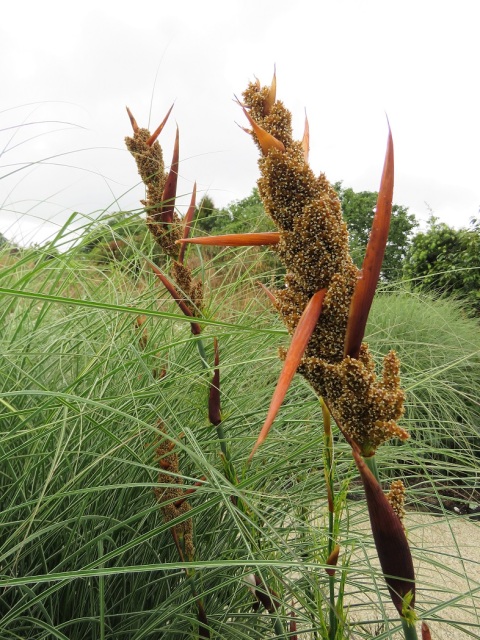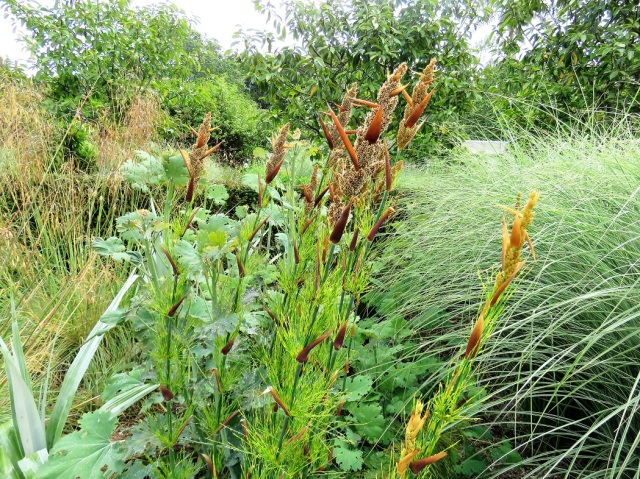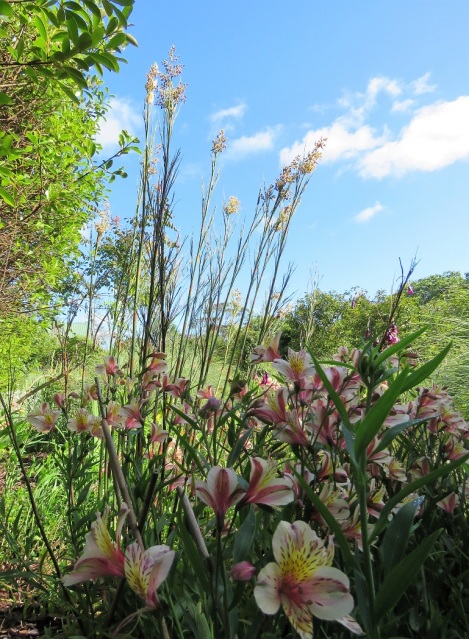
I lost count of the number of times we were asked about Elegia capensis during our recent open days. I have used it extensively with the grasses in the new Court Garden and it is looking rather splendid.
Its common name is the horsetail restio and the entire restionaceae plant family hails from South Africa. There are plenty of them but E. capensis is the most common in ornamental gardens. It is not too fussy on conditions as long as it never dries out entirely and is not subjected to very cold winters.
Most visitors described it as looking like a bamboo but with feathery growth, which is apt. The new shoots come up in spring like narrow bamboo shoots, first developing brownish sheaths at points up the stem before growing the fine foliage in tiers. The stems last about three years before dying off.

Our plants have never set viable seed. Whether that is because they are all one clone and they need other clones to set seed or whether it is the lack of smoke from bushfires, we are not sure. They may even be fully dioecious – needing both male and female plants to set viable seed. These are plants that have evolved to deal with frequent fires (they sprout afresh from underground rhizomes). PlantzAfrica says: “The seeds react well to treatment with smoke or with the ‘Instant Smoke Plus’ seed primer. Without this treatment the germination rate is poor.” I have never even heard of Instant Smoke Plus before.
We used to produce a few to sell in the nursery but the death rate in production was high. I have only just discovered why. We assumed that they would be similar to other plants like hostas and rodgersias that grow from rhizomes. In other words, we would lift the plants in winter, separate the rhizomes and repot them ready for spring growth. Then I read somewhere that they should be divided in February – late summer – so we tried that and it was not particularly successful either. What I have since discovered is that their roots are very sensitive, making the plants difficult to propagate by division. They are evergreen and not overly hardy so they are in growth all the time, unlike plants like the aforementioned hostas which have a dormant period. Commercially, they are more commonly raised from seed.
Where we have been successful in dividing this elegia, it has not been by taking apart the rhizomes but by cutting off large chunks of the original plant and putting the entire chunk into the new location. When I say cutting off large chunks, this requires a strong person, a very sharp spade and sometimes an axe, to take off blocks that are about 20 cm across which need to be replanted straight away. Brute strength, not high-level skill.
I see BBC Gardeners’ World describe this plant as invasive, which I think is wrong. It doesn’t seed readily – or at all here. Nor does it run below the soil surface so it is not invading. It is, however, strong growing and can make a large clump in the right conditions and that large clump is not easy to reduce or eliminate because of the solid nature of the rhizomes.

What is setting out to be genuinely invasive is the Macleaya cordata, commonly known as the Plume Poppy which is interplanted with the elegia. We have it in a shade garden where it certainly ‘ran’ below the soil surface but not in a particularly problematic manner. In full sun in the Court Garden, it is not so much running as sprinting – in every direction including into the pristine new paths. Attractive it may be, but it is a worry. I may just have to leave it in the shade garden and find a less determined plant option for the sunny, grass garden.

We have another restio that I picked up from Terry Hatch at Joy Plants in Drury but I am not sure where – or if – I kept its species name. It is not as vigorous as the elegia so better suited to the perennial borders where I have it planted but lacks the immediate visual charm of the deep green colour and tiers of feathery foliage up the stem. There is no such thing as a perfect plant for all situations.
